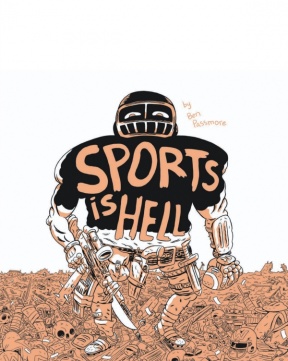In honor of yesterday’s Super Bowl, we revisit Ben Passmore’s powerful graphic novel.
Early on in “Sports is Hell,” one of our protagonists says, “it’s not the sports game fam, it’s the sports riot that i’m hyped about.” That sets the stage for this comic. It’s a fight between the rioting forces and the police, rioting forces and Nazis, and rioting forces of different philosophies. But in all cases, it’s about a riot.
Written and illustrated by Ben Passmore
Ben Passmore is the creator of “Your Black Friend,” the only mini-comic to make NPR’s “100 Favorite Comics And Graphic Novels.”
“Your Black Friend” is 11 pages about how carefully Passmore has to navigate being black in a world of soft racism, even among his well-meaning white friends.“Sports is Hell” is an extension of that mini-comic into 64 pages of an allegorical football riot. Passmore talks about race, revolution, and the role of entertainment and heroes. And I am 100% not equipped to review this book properly. (I am very white. I once accidentally joined in the South Boston St. Patrick’s Day Parade, and no one stopped me.) Here I go anyways.
In 2016, Colin Kaepernick kneeled during the national anthem in a football game, becoming another in a noble line of activists to use their position in sports, in these circuses, to advance their political cause. Passmore advances that in “Sports is Hell” to a full-scale football riot around a disputed flag thrown in the Super Bowl, a flag that will determine if The Birds win or lose against the Big Whites. We follow five people walking through the city and trying to make a difference, or at least make some sense. Two are a pair of punk anarchists who are happily tearing down the world, and are philosophically opposed to another who is trying to organize and channel all the anger into a building a better place. This hopeful revolutionary is looking for Wide Receiver Collins, a fictional stand-in for Colin Kaepernick, to become the new leader.
“Sports is Hell” is pretty short for a graphic novel, and features five main characters, but Passmore juggles the small ensemble cast through a full scale riot, letting these few people stand in for the whole. I don’t know how many of them have names, but I was able to rely on Passmore’s clear character drawings to know who’s who. Even in this book’s simple color scheme of black, white, and topaz, it’s always obvious who you’re looking at. Even the dialog of each character is distinct, the anarchists talk in lingo filed with twitter-isms rather than old-fashion revolutionary dialectics, and the white liberals talk about their feelings.
Passmore has become very adept comic artist. No two pages have the same layout, and he uses and drops panels whenever he wants, but it never feels forced. The story flows easily. And I want to take a minute to talk about his pages and pages of sound effects: Passmore isn’t reaching into a big bag of onomatopoeia, he finds everything he needs with “boom.”
I’d like to talk about the two white liberals, because they’re hilarious. They’re on their way to a Black Lives Matter protest (a movement that the author has become a bit suspicious of), and they’re swept up in the riot. For these two, rioting is just an experience, like poverty tourism. Their first few statements to a black person, who is just trying to ask them the time, are “we get stressed riding the bus,” “did you want some money,” and “we love black people!” There’s a beautiful beat where Passmore takes an empty panel to let world stand still while the questioning man mentally readjusts how he’s going to deal with this white couple.
It doesn’t end well for either of them, one is killed by the Nazi militia representing a minor football team called “The Nords.” “White on white violence? Typical.” is remarked on that death. The second one comes to end after being awarded a medal for bravery, sitting comfortably while violence continues around her, and then being shot when admits she doesn’t care for sports.
As you can tell, every moment in “Sports is Hell” is a loaded metaphor for race relations in America, and they’re all laid out easily and deeply. One character dies, thinking he’s finally found his savior, but we see immediately afterwards that it’s an anarchist imposter.
Through it all, the media is covering the riot like it was just another game. Television has been covering wars as easily as they cover sports since the 1990 Gulf War, and Passmore uses that in “Sports is Hell.” The talking heads segue effortlessly from the last quarter into the race riot like it was planned. It’s a more pointed use of media than you normally see in comics, which usually uses talking heads on television to just relay information.
This is a smart and incredibly dense comic, especially for just 64 pages. Passmore has a lot to say. I can’t wait to read everything else he creates.




